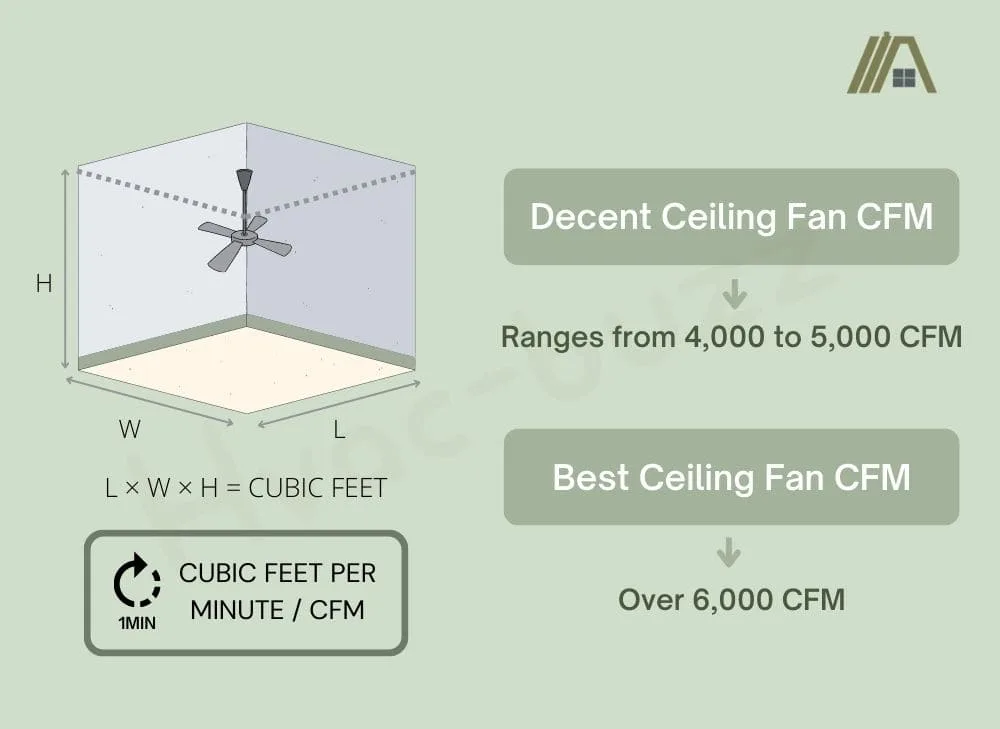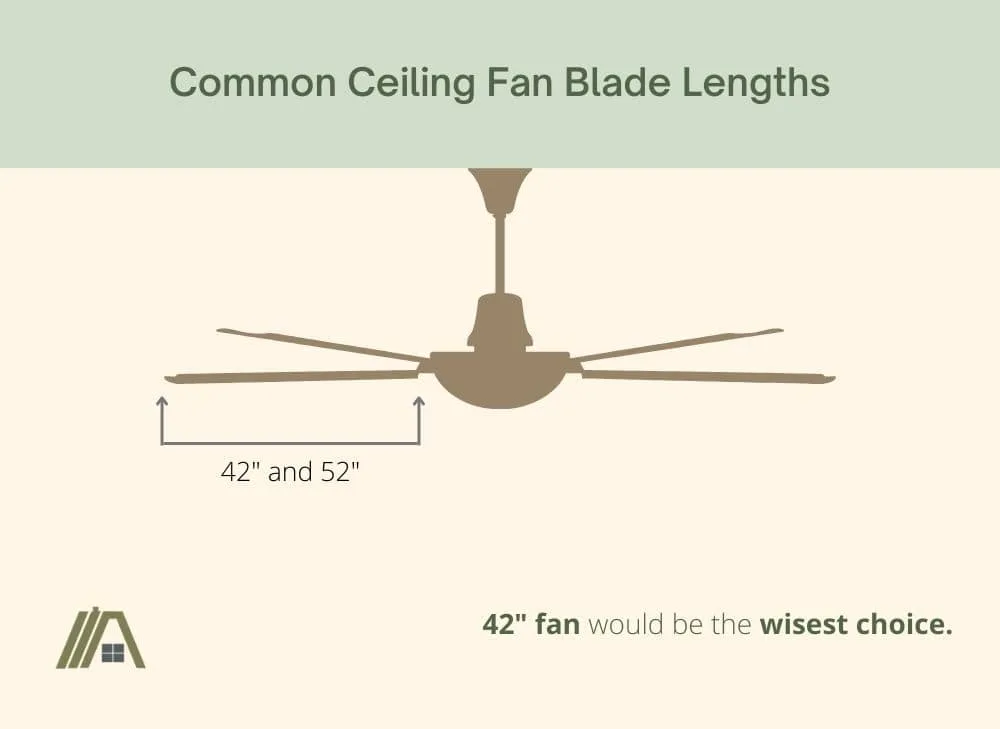Almost Efficient Ceiling Fan Blade Pattern (Highest Cfm Per Watt)
You would mean that the efficiency of a ceiling fan, equally far every bit it relies on the blades, would live represented by 1 design or at to the lowest degree a limited reach. Furthermore, it would live incomprehensible for ceiling fan manufacturers to create and sell fans that don’t move air very well. Yet, there is such variety in available ceiling fan blade designs.
It seems that all ceiling fan blade designs are effective at moving air, which is the primary part of a ceiling fan, but there are certain designs that make this more than efficiently. Furthermore, every bit certain aspects of the fan change, it tin influence what blade design is best.

Ceiling fan blade blueprint too efficiency present a complicated relationship. However, in full general, fewer, shorter, moderately wide paddle-shaped blades set at a pitch between ten°-xv° together with made from lightweight textile will live the near efficienct design at a fixed motor size.
What Is Considered a Good CFM Rating?
CFM stands for cubic feet per infinitesimal. It is a measure out of how much air is being moved by a fan over the course of a single infinitesimal.
Higher CFM way a greater capacity merely when it comes to efficiency, you take to look at how much power the fan uses to achieve this air drive.
A decent CFM ranges from four,000 to five,000 CFM, simply the best CFMs are over six,000.

In guild to live considered efficient, the fan must have an output of at to the lowest degree 75 CFM/W, merely yous become fans that pip 250 CFM/W and approximately that fifty-fifty transcend 400 CFM/west.
Ceiling fan blade blueprint covers the issue of blades, blade pitch, blade length, blade width, in addition to blade material.
Below nosotros volition expect at how all of these characteristics influence efficiency, and nosotros volition expect at them inward isolation for simplicity’sec sake. In other words, we will assume all other efficiency-influencing factors are constant.
How Many Blades Is It Best to Have?
More ceiling fan blades hateful the total blade surface surface area is greater, increasing the amount of air that the fan move, which positively influences efficiency. However, it besides increases the total of resistance generated by the fan blades, which negatively influences efficiency.
Overall, we can order that more than blades mean more than air is moved, only this is only true for a certain range of sizes. There is a indicate at which the number of blades becomes besides nifty for the motor (which we are assuming remains constant) to move effectively too airflow product decreases.
Furthermore, if the motor size stays constant, so every bit you lot increase the issue of blades, you make it harder for the fan to plough the blades. This agency that they purpose more ability per rotation. This means that increased airflow alongside increased blade issue doesn’t linearly interpret to amend efficiency.
Basically, when it comes to ceiling fan blade issue in addition to efficiency, we take to take the Goldilocks approach. Not besides many as well as non too few.
While truthful, the to a higher place data does non really assistance y'all when you lot are selecting a fan together with are trying to take the nearly efficient number of blades.
As far every bit the near airflow goes, four- too five-bladed fans take the highest CFM at half dozen,800 CFM. Three-bladed fans move, on average, six,700 CFM.
However, if nosotros wait at the wattage taken to generate the airflow, 3-bladed fans frequently come up out equally the most efficient, with an efficiency rating of around 248 CFM/westward.
Despite their efficiency, though, three-bladed fans are much noisier than fans amongst more blades since they must spin faster to achieve higher airflow.
Ideal Blade Pitch
Ceiling fan blade pitch tin be described as the angle that the ceiling fan blade makes amongst the horizontal plane. Blade pitch is decided by a residual of airflow in addition to drag, similar to the issue of fan blades.
When a ceiling fan blade is really horizontal, at that place is trivial drag because the surface expanse having to move through the air is really small-scale. At the same time, the surface surface area is then pocket-size that not much air is existence moved past the blades.
By comparison, a fan blade that is really vertical generates a lot of airflow every bit it moves, but the drag increases, then the blades are harder to move.
In general, a higher pitch agency higher airflow, just the efficiency is compromised afterwards a sure point together with the angle must be lessened to minimize drag.
This leaves us with a “sugariness spot” reach between 10° together with 25°. Within this range, the ceiling fan’second dispersal surface area is what varies.
The lower pitches (ten-fifteen°) accept slightly lower airflow just a higher dispersal surface area. This is ideal for residences.
On the higher side (25°), the airflow is slightly higher merely is more concentrated as well as has a lower dispersal expanse. This is more than ideal for industrial settings.
What Should the Length of the Blade Be?
In almost situations, a shorter blade would hateful a higher efficiency because the shorter blades are lighter as well as require less ability for rotation. They as well have a smaller surface area to create drag.
Once once more, in that location is a bespeak where this statement is no longer truthful because if the fan blades get as well small, the surface surface area alongside which they tin move air is besides pocket-sized to brand them effective.
It is true that increasing the length of ceiling fan blades increases the total of airflow created. However, this human relationship is strongly dependent on the motor size increasing to move these longer blades. Stronger motors draw more than ability, and then longer blades tend non to live the near efficient selection.
Two ceiling fan blade lengths that are the common are 42″ in addition to 52″. If y'all would like increased airflow efficiency, the 42″-fan would live the wisest choice.

It is possible to shorten ceiling fan blades with the proper safe precautions. It tin can be a slow in addition to peradventure unsafe process, simply the airflow in your dwelling house can benefit from this if a shorter blade size is not available to you lot.
Are Thin or Wide Blades More Efficient?
As far as what fan width is the best, there isn’t a straightforward answer for this 1 either. The best selection for you lot largely depends on the other aspects of your fan.
Thin blades create less airflow merely as well make less drag. Wide blades make more than airflow and more drag.
Although it makes sense to say that wide blades are the best for airflow, if your fan already creates a large sum of drag, wide blades may boundary the airflow efficiency by using besides much ability to go the motor too rotate the blades.
The best instance of this is if your fan has more than 5 blades. The larger total of blades would create more drag and broad blades would non be efficient in this scenario.
If your fan has less than four blades, broad blades could be a adept pick since the motor would non be equally overloaded equally it would live alongside more blades.
The selection of what is the near efficient depends on the current load of your ceiling fan motor too how much more than drag it can handle.
Overall, I would order that a moderately broad fan blade that is paddle-shaped would live an efficient blueprint.
Does the Blade’sec Material Affect the Fan’sec CFM?
Not entirely does the material of a ceiling fan blade affect the fan’sec CFM, just the cloth of the fan is ane of the nigh of import factors that bear upon the fan’second efficiency.
This is because, depending on the cloth, the ceiling fan’s weight will vary.
- A fully metal 52″ ceiling fan will weigh nearly 20.three lbs.
- A 52″ ceiling fan made of woods as well as close to metal would weigh well-nigh eighteen.iv lbs.
- A plastic 52″ ceiling fan would weigh nigh twenty.77 lbs.
Although these weights don’t differ dramatically, a lilliputian departure can become a long style.
When weight is reduced from a fan, this takes a load off of the motor. This allows the motor to increase the fan speed together with, therefore, increases airflow for the same total of power drawn from the circuit.
Sources
https://www.ylighting.com/weblog/take-ceiling-fan/
https://www.ceilingfan.com/ceiling-fan-blades-touch on-the-character-of-a-fan-s
https://www.rsandrews.com/blog/whats-the-divergence-betwixt-ceiling-fan-blades/


Comments
Post a Comment